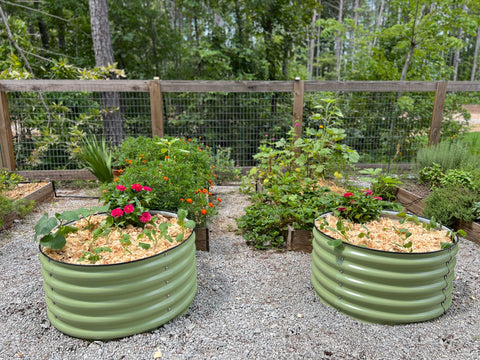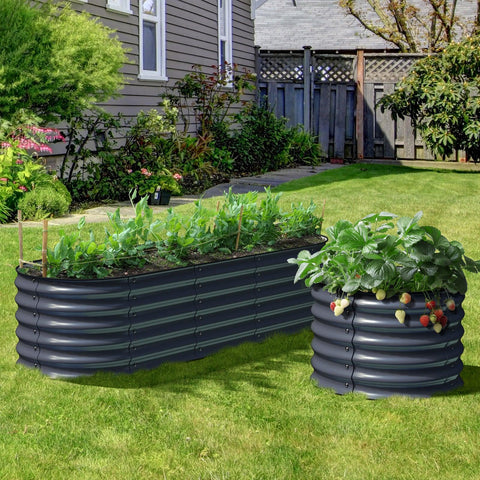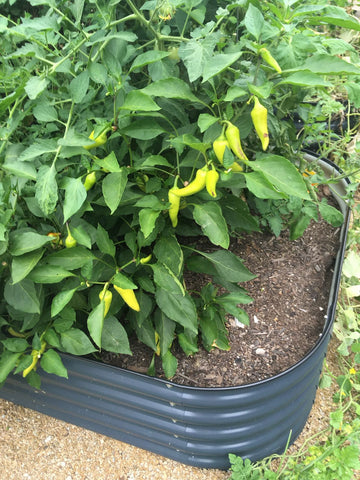Tips from Olle Garden Bed:How to Winterize And Protect Your Garden
It's the most wonderful time of the year. Apple picking, pumpkin carving and yes, taking care of your garden after harvesting the last crop. When we have garden beds and blooming plants it is easy to forget about the other aspects of caring for them...like winter care. Like so many things in life there is a right way and a wrong way to take care of your garden in winter. This list will help guide you through some common sense practices that will ensure your long term enjoyment of your garden. Below are some quick tips if you have time:

1. Harvesting and storage of vegetables
A. Young vegetables are not frost resistant and should be harvested before frost strikes. This includes tomatoes, zucchini, peas, beans, wax gourds and pumpkins. Pull out the residual yellow of these plants and all crops. If any plants get sick, either burn them or throw them in the trash. Do not leave infected plants on the property or pile compost in compost.
B. Cold resistant vegetables can withstand severe frost (usually 25 ° to 28 ° F) and can be left underground. They usually taste better after a slight frost.
Brussels sprouts can be left underground. Bury plants in hay or leaves in late autumn, and then pull out small buds as needed in winter.
Vegetables such as cooking kale and kale will actually become sweeter when exposed to frost in autumn and winter.
Broccoli and spinach can also spend winter without any protection.
Garlic is planted in October or November and will overwinter in the summer crop next year.
C. Semi hardy vegetables can tolerate slight frost (usually 29 ° to 32 ° F). Many of these slightly sensitive crops benefit greatly from some kind of protection, such as cold racks or floating row mulches; Or, you can simply harvest them before the severe frost comes.
Cabbage and Swiss chard can withstand slight frost, but the outer leaves may be damaged or hardened (peel them off before using the rest of the vegetables).
Sesame, leek, mustard, kali, English peas and turnips may die if they are not protected during the extreme winter cold. A simple row cover can change everything.
Root crops (such as carrots, radishes, beets, turnips and parsnips) can be left in the garden after frost and can be removed intact later, but they will be dug up and stored before the ground actually freezes.
Potatoes can also be left in the soil, but it is important that they are not left on the soil surface at any time. Dig out potatoes and move them to a dry, warm place, away from the sun, and begin the process of hardening the skin for storage. Single layer drying and regular turning. It will take about two weeks. Carefully remove visible dirt from potatoes, but do not wash them: their skin will harden for longer winter storage.
Note: Make sure that any vegetables you harvest are salted and stored properly. Of course, many crops can also be stored by canning and pickling. Finally, herbs can be easily dried or frozen in many ways.
2. Prepare herbs for winter
When it comes to winter protection, herbs are a mix pack. Some are very hardy and can easily endure the cold season, while others need some extra help:
Salvia is a perennial plant in most areas, and no special treatment is required in winter. Before the frost stops growing, cut one or two branches to dry, and use them for stuffing on Thanksgiving Day! Try our delicious sage turkey recipe.
Rosemary is a tender evergreen perennial plant, which should be protected outside (Zone 6 and 7), or potted and brought inside (Zone 5 and colder) for winter. Read more about wintering rosemary.Thyme is quite indestructible. It is a perennial plant, dormant in autumn, and then revives itself in spring.
The parsley, once every two years, will withstand a slight frost. In Zone 5 or colder areas, cover on cold nights. Its taproot is very long and the transplant effect is not good, so you'd better start a new plant in spring.
The chives are hardy perennial plants. Dig it up and pot it, then let the leaves wither and freeze for several weeks. Take the pot to a sunny and cool place indoors. Water and harvest leeks throughout the winter.
Basil is a gentle annual plant, which cannot be wintered outside in most parts of North America. Dig out small plants and bring them indoors to prolong their season.
Oregano is a perennial plant, some of which are hardy, but can provide some winter protection in the form of a layer of straw cover.
3. Cover the garden bed
Many of us will eventually add it in spring, but you really want to add compost in late autumn so that the soil can absorb these nutrients in winter. Add a few inches of compost or manure to the bed at any time before the ground freezes. Then, add a thin layer of straw or mulch to prevent soil erosion, nutrient leaching and weed growth.
Another option is to plant mulch crops, such as winter rye, to improve the soil.
Another option for a vegetable garden is simply to cover your garden bed with black plastic or a layer of cardboard or even an old carpet and leave it in winter until you are ready to plant it in spring. This will kill existing weeds and overpower germinating seeds.
4. Prepare berry patches for winter
Berries are often hardy, but may require some autumn pruning and care:
Early autumn to early autumn:
Prune summer raspberries, leaving six of the strongest brown cane per foot of patch.
Prune the fallen raspberries ruthlessly, and cut them to the ground after they bear fruit. New sugarcane will appear and bear fruit in spring.
Plant blackberries in autumn and pile soil around sugar cane to prevent hard frost from lifting them from the ground.
Many blueberry varieties are hardy, but they like to apply a thin covering around the base to increase protection.
Cover the strawberry bed with a straw cover.

5. Prepare perennial plants for winter
Water your perennial flowers and flowering shrubs in autumn; They will thank you this winter.
Many perennial plants can be cut down in spring, especially those with rich seed heads, such as pine cones or rudbeckia, because birds will enjoy their seeds throughout the winter. However, there are some perennial plants that are best reduced to avoid spreading diseases - such as powdery mildew - especially bee balm, phlox and host. See which perennials should be reduced. When cutting, wait until the ground freezes hard and leaves die. Leave about 3 inches of stems and cover them with thick leaves or straw.
If you plan to install a new flower bed next spring, cover the area with mulch or thick plastic now to prevent weeds from growing when the ground is warm in spring. If the new bed is to be placed on the current lawn, please cut as much grass as possible in the area before covering.
Before heavy snow falls, cover the skin with pine needles several inches deep.
When the flowers wither, move the potted chrysanthemums to shelter from the wind. Water well and cover with thick straw for winter.
When the frost blackens the leaves of dahlia, gladiolus and canna, carefully dig them out and let them dry on the indoor newspaper for a few days. They are then packaged in foamed plastic peanuts, dry peat moss or shredded newspapers and stored in a dark, humid place at 40 ° to 50 ° F (5 ° to 10 ° C) until spring.
6. Winter rose
You can water roses regularly in autumn; Avoid applying fertilizer 6 weeks before the usual date of the first autumn frost.
Remove any dead or sick cane.
After the first frost, cover the plant with compost or leaves to make it just above the swelling point where the stem connects with the stock.
In areas with severe winter temperatures, wrap low growing roses with solid chicken shreds or mesh tubes, and fill fences with chopped leaves, compost, mulch, dried wood chips or pine needles.
Before the daily temperature drops below freezing point, carefully pull down the long walking sticks of climbing and tea roses, lay them flat on the ground, and cover them with pine branches or coverings.
7. Prepare trees and shrubs for winter
Don't trim trees and shrubs before winter. Even if they look a little weedy, they will wait until next spring. Trimming involves removing tissue and opening wounds that have no time to heal before the cold sets in. Pruning also stimulates trees or shrubs to try to grow, but any new growth that occurs in autumn can be killed because it does not have any time to harden or become more woody.
If there is early snow in your area, please cover small trees and deciduous shrubs with wooden structures to protect them from heavy snow. Or, surround them with a wire fence and fill the space between the tree and the fence with straw or broken leaves. Or, drive the wooden pile into the ground at four corners around the plant, wind burlap or heavy plastic around the pile, and fix it at the top, center and bottom with hemp rope.
For young fruit trees, it is usually best to wrap the lower trunk of the tree with an insect resistant tree to prevent rats and voles from gnawing on the bark in winter.
Tree wrapping also helps prevent winter damage from premature thawing. At the end of winter, the combination of warm, sunny days and still cold nights can cause the thin bark of young trees to crack. This is particularly common in exposed trees in the south or southwest. Wrapping the trunk with bark or otherwise blocking the winter sun can prevent bark injury.
If you plan to buy a live Christmas tree in this season, please dig a hole before the ground freezes and plant it there. Store the soil you remove in the garage or basement where it will not freeze. Put a board on the hole and mark the position so that you can find it when it snows.
8. Close the watering system
If you haven't turned off the water, go ahead! You do not want to connect the hose or irrigation when it is frosting, otherwise it may be damaged. In warm climates, you can simply disconnect the system from the hose faucet and let the water drain, but in colder climates, you need to use an air compressor to drain all the water, or just bring everything into it for winter.

9. Help your garden helper!
Be proactive! Keep the bird feeder alive. In cold months, birds especially like fatty and high-energy foods (such as suet). Establish feeding procedures, provide water regularly, and clean the feeder and birdbath to maintain good hygiene habits.
10. General garden maintenance
Empty all outdoor containers to prevent them from cracking in winter. Store them upside down.
Hang the bucket on the hook in the tool shed or garage and use it to store hose nozzles and sprinkler accessories.
As the grass grows, mow the lawn in late autumn. When deep snow comes, too long grass will form brown patches in spring.
Don't leave fallen leaves in the sodden layers of the lawn. Rake it onto a large piece of paper or waterproof cloth, and then drag it to a corner of the yard to give pollinators some winter cover. Or, rake the leaves into loose piles, and then run a lawn mower over them, turning them into mulch for perennial and bulb beds. Alternatively, add these chopped leaves to the compost bin.
Before snow falls, cover the compost pile with plastic or thick straw.
Drain the fuel tank from the mower or any other powered equipment.
Wipe and stow tools. Some people oil tools with vegetable oil to avoid rust.
